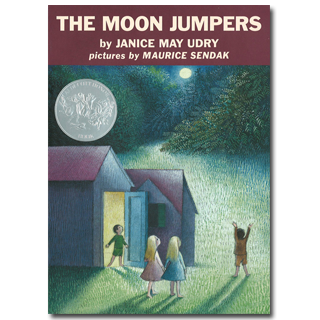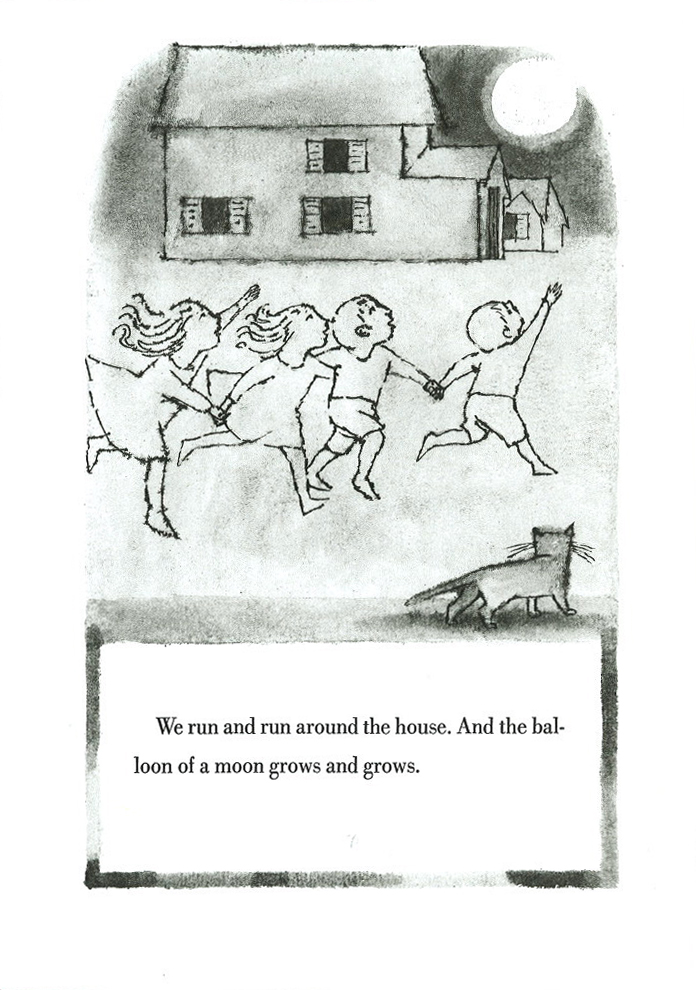
A FEW OTHER EVENTS FOR
MARCH 27:
- Happy birthday Patricia C. Wrede (The Enchanted Forest Chronicles) and Julia Alvarez (Return to Sender, Before We Were Free).
- It’s the birth date of Dick King-Smith (1922–2011), Martin’s Mice, The Water Horse, and Babe: The Gallant Pig, who died very recently (January 4) at the age of 88.
- On this day in 1886, Geronimo, an Apache warrior and chief, surrendered to the U.S. Government after a thirty-year struggle to protect his tribe’s homeland. Read Geronimo by Joseph Bruchac and I am Apache by Tanya Landman.
March 30th marks the New Moon, and moon cycles always remind me of a 1957 title by Janice May Udry, The Moon Jumpers, which won a Caldecott Honor for its illustrator, Maurice Sendak when he was just thirty years old.
It has now been almost two years since Maurice’s death, and the outpouring of affection for him both from individuals and the news media has been wonderful to watch. For adult fans of Sendak, his last work, My Brother’s Book, has just been posthumously published and is a delight for anyone who loves entering Sendak’s unique, iconographic world. In 1963 when Sendak won the Caldecott for Where the Wild Things Are, he changed the face of the American picture book and became its reigning genius—a position he maintained for almost fifty years. No one in that time period thought more about picture books, what they can do, and how they might best be structured.
But I often wish that the more than fifty picture books that Sendak crafted before Where the Wild Things Are got more attention. In these books Sendak was not conscious of being an illustrator who was shaping the field and hence had more freedom and latitude to play with his art. There is lightness, spontaneity, freshness in early Sendak—A Hole is to Dig, the Little Bear series, The Sign on Rosie’s Door, or Mr. Rabbit and the Lovely Birthday Present.
In The Moon Jumpers, Sendak alternates black-and-white pages with full-color spreads, something done frequently in the fifties to keep the cost of book production down. “The sun is tired. It goes down the sky into the drowsy hills. The sunflowers lean. They fall asleep to dream of tomorrow’s sun,” the story begins. And then a group of children, substantial, rounded, vibrant children go out to play in the dark. They make up stories, turn somersaults, and run round and round the house as the full moon dominates the sky. Finally called to bed, they gaze at the full moon and dream of tomorrow’s sun.
A quiet book, a bedtime story, The Moon Jumpers has been transformed from an ordinary tale to an extraordinary one by Sendak’s art. A simple childhood experience has been given dignity and grace as he presents the children engaged in their antics. Their backyard turns magical in his hands, just as these children experience it. They play and romp, needing only a full moon to make an evening special.
Even though we now live in a world without Maurice, I am so grateful that we still have his glorious books. How wonderful that we can go back to them, any day of the year, to be with him once again.
Here’s a page from The Moon Jumpers:
Originally posted March 27, 2013. Updated for 2024.














It seems every day I find myself hoping to find a really great children’s book that I haven’t know about.
Well, I got my wish this morning. Though I knew about Udry’s “A Tree is Nice” I somehow missed “The Moon Jumpers” and after reading Anita’s essay on it, I went out and found it this morning.
The art is splendid. The story is as good as the art and there are lines from this book you won’t be able to forget. It’s perfect. So much so, I may just have to sit in a tree tonight and read The Moon Jumpers” gain. (Well, maybe under a tree at least.)
I consider this essay a gift. And it is a gift, to discover such a treasure one can read and own for life. And the back-story is like a magic wand ribbon-tied on top of the box.
Great essay!
Gordon: Thanks for your vote of confidence. It is always wonderful to introduce you to a “new” book — books are, of course, new when we find them.
I think the books of Ruth Krauss that were illustrated by Maurice Sendak are sublime. (Ruth Krauss needs more recognition, IMO)
Is this available at public library? I love your site. Thanks for the wonderful information.
Katie — I would check right away at your local library.